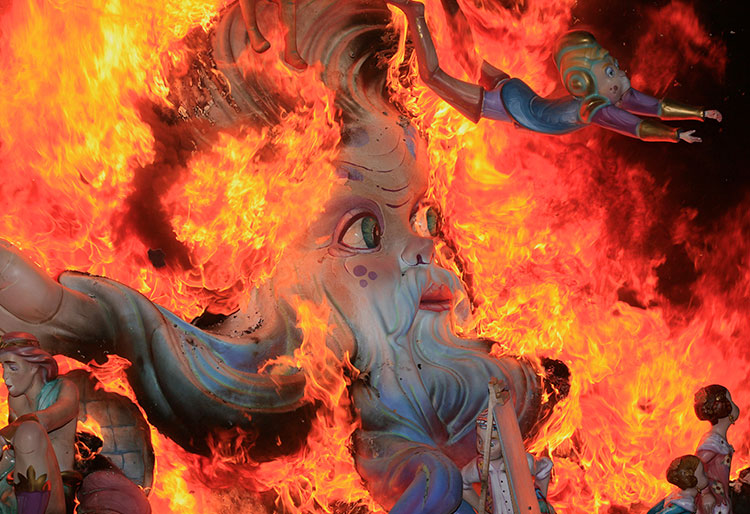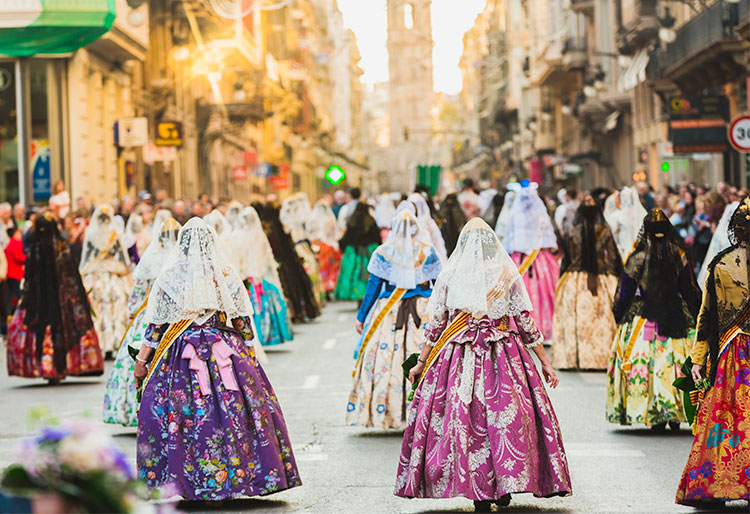What to do during the Fallas
During the month of March, Valencia celebrates it great festival. But what is there to do during the Fallas? What events should we not miss? How do Valencians celebrate their festival?
TRAVELLING WITH TASTE
Share

The essential events:
1 March: La Crida (the Call)
The Head Fallera of Valencia invites everyone to visit the city’s great festival. Although some activities are celebrated before this time, this is the true start of the Fallas. Generally, the festival takes place on the last Sunday of February, but this year, 2020, they will be celebrated on 1 March.
8.00pm. Torres de Serranos.
15 March: La Plantà (building the bonfire)
All the monuments for the Fallas are erected so that they can be viewed until the Cremà (the burning). The children’s fallas should be completely ready for the judges to evaluate them at 9am. The larger monuments should be completely ready for the review at dawn on the 15 to 16 March.
17 and 18 March: La Ofrenda (the Offering)
The Offering of Flowers to the Virgin is one of the most emotional and well-attended activities of the Fallas. It consists of taking flowers from each falla to the Plaza de la Virgen where there is an enormous wooden bust of the patron saint of the city, the Virgen de los Desamparados. The bunches of flowers are placed on the wooden frame and form the shape of the shawl. There are two routes: one passes along the calle de la Paz, and the other along calle San Vicente. Both routes end at the Plaza de la Virgen, and both pass through the Plaza de la Reina.
From 3.30pm.
19 March: La Cremà (the Burning)
After 4 intense days full of colour, firecrakers, flowers and music, Valencia returns to its normal pace after the Nit de la Cremà. All the monuments are burned in the streets as an emotional farewell to the festival which has fire and music as its main theme. The children’s fallas are set on fire at 10.00pm and the main ones, from midnight.
12 midnight

Firework displays
Apart from the more solemn fallas activities, another of the main attractions of this street festival to welcome the spring, are the performances of sound and colour. The basic ones are:
• La Despertà (the awakening): this one is the most highly thought of by the falleros, and the most detested by their neighbours. As the fallas take place for 4 days - but for 24 hours of each day - you should not waste any time sleeping. For this reason, at 8.00am each morning the falleros let off firecrackers along the streets of their neighbourhoods accompanied by musicians in order to wake up their neighbours and to encourage them to enjoy the festival.
• La Mascletà (thefireworks): this is the discharge in sequence of powerful firecrakers to create noise. Traditionally, the event was just noise, although it can also include colour. It takes place each day in the Plaza del Ayuntamiento at 2pm between 1 and 19 March. The event is short-lived, normally no longer than 5 minutes, but many people attend, so it is best to get there early to find a space. Many of the fallas commissions also organise their own mascletàs in their neighbourhoods, although of course, these are less intense.
• La Nit del Foc (the Night of Fire):: fireworks castles are essential during the Fallas, particularly those on the night of 18 March, which is la Nit del Foc. This is the last event of the festival and tends to be the best. The event, which takes place at the high part of La Alameda on the old riverbed of the Turia River, combines colour, sound and effects of light and movement. It lasts for roughly between 15 and 20 minutes and ends with a final firecracker. An hour before it begins, generally well into dawn and always when the Head Fallera of Valencia and their Court of Honour have completed the Offering, the two banks of the old river begin to fill with people.






